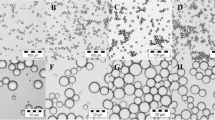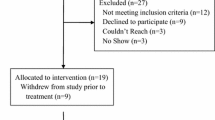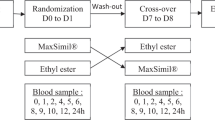Abstract
Lipid emulsions are made by mixing vegetable and/or fish oils with egg yolk and contain different types and amounts of fatty acids and sterols. This study assessed the effects of oral diet, soybean oil (SO)-, fish oil (FO)-, a mixture of olive and soybean oil (OOSO)-, and a mixture of fish, olive, coconut, and soybean oil (FOCS)-based emulsions on plasma triacylglycerols and plasma and tissue fatty acid and sterol content following acute and chronic intravenous administration in the guinea pig. Upon acute administration, peak triacylglycerols were highest with SO and lowest with OOSO. Upon chronic administration, the plasma triglyceride levels did not increase in any group over that of the controls. Fatty acid levels varied greatly between organs of animals on the control diets and organs of animals following acute or chronic lipid administration. Squalene levels increased in plasma following acute administration of OOSO, but plasma squalene levels were similar to control in all emulsion groups following chronic administration. Total plasma phytosterol levels were increased in the SO, OOSO, and FOCS groups following both acute and chronic infusions, whereas phytosterols were not increased following FO infusion. Total phytosterol levels were higher in liver, lung, kidney and adipose tissue following SO and OOSO. Levels were not increased in tissues after FO and FOCS infusion. These results indicate that fatty acid and sterol contents vary greatly among organs and that no one tissue reflects the fatty acid or sterol composition of other tissues, suggesting that different organs regulate these compounds differently.



Similar content being viewed by others
Abbreviations
- ALP:
-
Alkaline phosphatase
- ALT:
-
Alanine aminotransferase
- AST:
-
Aspartate aminotransferase
- CO:
-
Coconut oil
- DHA:
-
Docosahexaenoic acid
- DPA:
-
Docosapentaenoic acid
- EPA:
-
Eicosapentaenoic acid
- FO:
-
Fish oil emulsion
- FOCS:
-
Fish, olive, coconut and soybean oils emulsion
- OOSO:
-
Olive and soybean oils emulsion
- GC:
-
Gas chromatography
- HDL-C:
-
High density lipoprotein-cholesterol
- LCT:
-
Long-chain triacylglycerols
- LDL-C:
-
Low density lipoproteins-Cholesterol
- LDL-R:
-
Low density lipoprotein receptor
- LE:
-
Lipid emulsion
- LPL:
-
Lipoprotein lipase
- MCT:
-
Medium chain triacylglycerols
- PUFA:
-
Polyunsaturated fatty acids
- PNALD:
-
Parenteral-nutrition associated liver disease
- RBC:
-
Red blood cells
- SO:
-
Soybean oil emulsion
- TG:
-
Triacylglycerols
References
Rustan AC, Drevon CA (2005) Fatty acids: Structures and properties. In: Encyclopedia of life sciences. John Wiley, pp 1-7
Gurr M, Harwood J, Frayn K (1989) Lipid biochemistry: an introduction. 5th edn. Blackwell Science, Oxford, UK
Xu Z, Harvey K, Pavlina T, Dutot G, Zaloga G, Siddiqui R (2011) An improved method for determining medium- and long-chain FAMEs using gas chromatography. Lipids 45:199–208
Xu Z, Harvey KA, Pavlina T, Dutot G, Hise M, Zaloga GP, Siddiqui RA (2012) Steroidal compounds in commercial parenteral lipid emulsions. Nutrients 4:904–921
Ostlund RE Jr (2002) Phytosterols in human nutrition. Annu Rev Nutr 22:533–549
Subbiah MT (1973) Dietary plant sterols: current status in human and animal sterol metabolism. Am J Clin Nutr 26:219–225
Salen G, Ahrens EH Jr, Grundy SM (1970) Metabolism of beta-sitosterol in man. J Clin Invest 49:952–967
El Kasmi KC, Anderson A, Devereaux MW, Noe MS, Sokol RJ (2011) Soy lipid-derived phytosterols are responsible for parenteral nutrition associated liver injury (PNALI) in a mouse model. Hepatology 54(suppl):412A
Iyer KR, Spitz L, Clayton P (1998) New insight into mechanisms of parental nutrition-associated cholestasis: role of plant sterols. Journal of Pediatric Surgery 33:1–6
Carter BA, Taylor OA, Prendergast DR, Zimmerman TL, Von Furstenberg R, Moore DD, Karpen SJ (2007) Stigmasterol, a soy lipid-derived phytosterol, is an antagonist of the bile acid nuclear receptor FXR. Pediatr Res 62:301–306
Shefer S, Salen G, Nguyen L, Batta AK, Packin V, Tint GS, Hauser S (1988) Competitive inhibition of bile acid synthesis by endogenous cholestanol and sitosterol in sitosterolemia with xanthomatosis. Effect on cholesterol 7 alpha-hydroxylase. J Clin Invest 82:1833–1839
Boberg KM, Akerlund JE, Bjorkhem I (1989) Effect of sitosterol on the rate-limiting enzymes in cholesterol synthesis and degradation. Lipids 24:9–12
Clayton PT, Whitfield P, Iyer K (1998) The role of phytosterols in the pathogenesis of liver complications of pediatric parenteral nutrition. Nutrition 14:158–164
Kelly DA (2010) Preventing parenteral nutrition liver disease. Early Hum Dev 86:683–687
Clayton PT, Bowron A, Mills KA, Massoud A, Casteels M, Milla PJ (1993) Phytosterolemia in children with parenteral nutrition-associated cholestatic liver disease. Gastroenterology 105:1806–1813
Ellegard L, Sunesson A, Bosaeus I (2005) High serum phytosterol levels in short bowel patients on parenteral nutrition support. Clin Nutr 24:415–420
Llop JM, Virgili N, Moreno-Villares JM, Garcia-Peris P, Serrano T, Forga M, Solanich J, Pita AM (2008) Phytosterolemia in parenteral nutrition patients: implications for liver disease development. Nutrition 24:1145–1152
Clinolipid (lipid injectable emulsion, USP), 20 % - Accessdata FDA. WWW.accessdata.fda.gov
Team RDC (2008) R: A language and environment for statistical computing. Austria, Vienna
Hallikainen M, Huikko L, Kontra K, Nissinen M, Piironen V, Miettinen T, Gylling H (2008) Effect of parenteral serum plant sterols on liver enzymes and cholesterol metabolism in a patient with short bowel syndrome. Nutr Clin Pract 23:429–435
Dimakou K, Guillotte C, Hill S Phytosterols of HPN patients. In: The 34th ESPEN Congress, Barcelona, Spain, 2012. Clinical Nutrition Supplements, p 135
Beale EF, Nelson RM, Bucciarelli RL, Donnelly WH, Eitzman DV (1979) Intrahepatic cholestasis associated with parenteral nutrition in premature infants. Pediatrics 64:342–347
Van Aerde JE, Duerksen DR, Gramlich L, Meddings JB, Chan G, Thomson AB, Clandinin MT (1999) Intravenous fish oil emulsion attenuates total parenteral nutrition-induced cholestasis in newborn piglets. Pediatr Res 45:202–208
Nehra D, Fallon EM, Puder M (2011) The prevention and treatment of intestinal failure-associated liver disease in neonates and children. Surg Clin North Am 91:543–563
Cober MP, Killu G, Brattain A, Welch KB, Kunisaki SM, Teitelbaum DH (2012) Intravenous fat emulsions reduction for patients with parenteral nutrition-associated liver disease. J Pediatr 160:421–427
Allardyce DB (1982) Cholestasis caused by lipid emulsions. Surg Gynecol Obstet 154:641–647
Cavicchi M, Beau P, Crenn P, Degott C, Messing B (2000) Prevalence of liver disease and contributing factors in patients receiving home parenteral nutrition for permanent intestinal failure. Ann Intern Med 132:525–532
Puder M, Valim C, Meisel JA, Le HD, de Meijer VE, Robinson EM, Zhou J, Duggan C, Gura KM (2009) Parenteral fish oil improves outcomes in patients with parenteral nutrition-associated liver injury. Ann Surg 250:395–402
Fernandez ML (2001) Guinea pigs as models for cholesterol and lipoprotein metabolism. J Nutr 131:10–20
Olivecrona T, Bengsston-Olivecrona G (1993) Lipoprotein lipase and hepatic lipase. Curr Opin Lipidiol 4:187–196
Fernandez ML, Yount NY, McNamara DJ (1990) Whole body and hepatic cholesterol synthesis rates in the guinea-pig: effect of dietary fat quality. Biochim Biophys Acta 1044:340–348
Angelin B, Olivecrona H, Reihner E, Rudling M, Stahlberg D, Eriksson M, Ewerth S, Henriksson P, Einarsson K (1992) Hepatic cholesterol metabolism in estrogen-treated men. Gastroenterology 103:1657–1663
McNamara DJ, Ensign W, Montano C, D.M. S, Soscia A (1993) Exercise and plasma lipoproteins in the guinea pig. Faseb J:A869
Hidaka K, Takada Y, Matsunaga A, Sasaki J, Arakawa K (1992) Effects of probucol on low-density lipoprotein catabolism in guinea pigs. Artery 19:162–176
Berglund L, Sharkey MF, Elam RL, Witztum JL (1989) Effects of lovastatin therapy on guinea pig low density lipoprotein composition and metabolism. J Lipid Res 30:1591–1600
Suckow MA, Stevens KA, Wilson RP (2012) The laboratory rabbit, guinea pig, hamster, and other rodents. Academic Press, Salt Lake City, UT
Acknowledgments
The authors wish to thank Elaine Bammerlin for providing editorial assistance and Dr. Cary Mariash for the statistical analysis of data. This study was supported by a grant from Baxter Healthcare Corporation, Deerfield, IL 60015, USA.
Conflict of interest
All authors declare no conflict of interest.
Author information
Authors and Affiliations
Corresponding author
Electronic supplementary material
Below is the link to the electronic supplementary material.
About this article
Cite this article
Harvey, K., Xu, Z., Walker, C. et al. Parenteral Lipid Emulsions in Guinea Pigs Differentially Influence Plasma and Tissue Levels of Fatty Acids, Squalene, Cholesterol, and Phytosterols. Lipids 49, 777–793 (2014). https://doi.org/10.1007/s11745-014-3927-2
Received:
Accepted:
Published:
Issue Date:
DOI: https://doi.org/10.1007/s11745-014-3927-2




